The ASUS Scar 15 is the newer version of the Scar 3 from last generation, so it’s still covered in the all important RGB lighting. I’ll show you what changes this newer 10th gen model has in store for us in this detailed review. 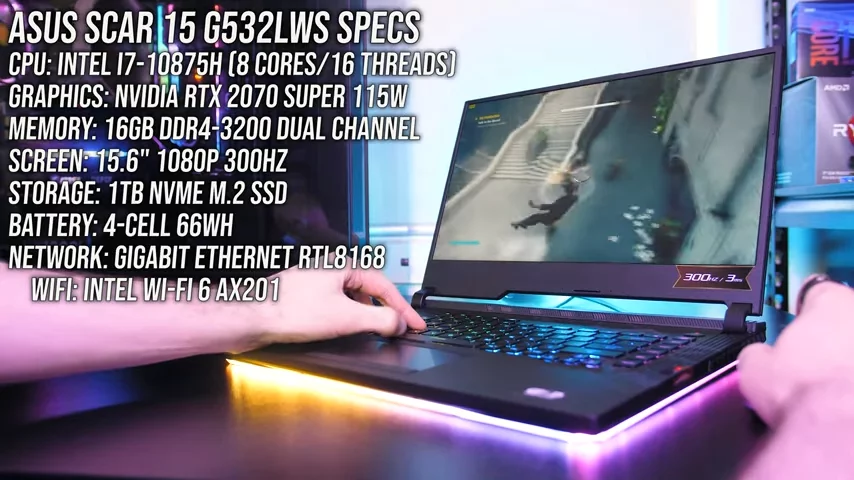 The overall design is very similar to the 9th gen Scar III from last year, it’s got a matte black metal lid and a smooth black plastic interior with a subtle ROG design on the top right.
The overall design is very similar to the 9th gen Scar III from last year, it’s got a matte black metal lid and a smooth black plastic interior with a subtle ROG design on the top right. 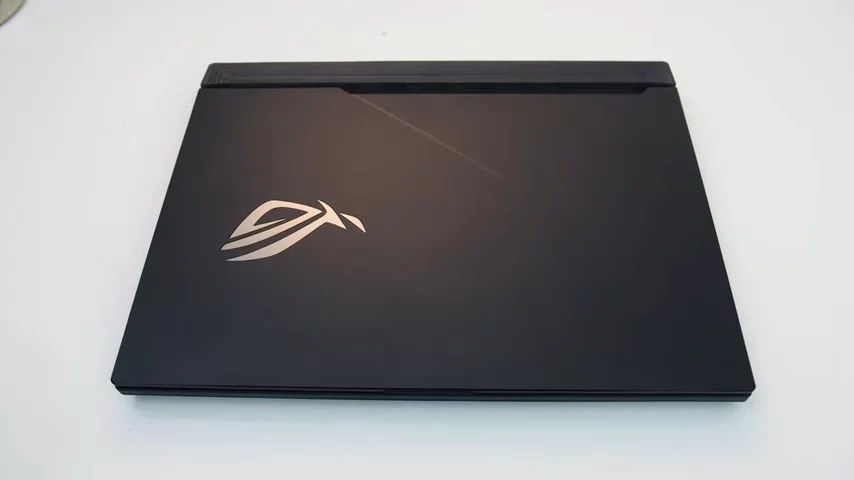 The build quality was decent, no sharp corners or edges, and flex to both the keyboard and the lid were on the lower side, it was quite solid and fine during normal use.
The build quality was decent, no sharp corners or edges, and flex to both the keyboard and the lid were on the lower side, it was quite solid and fine during normal use. 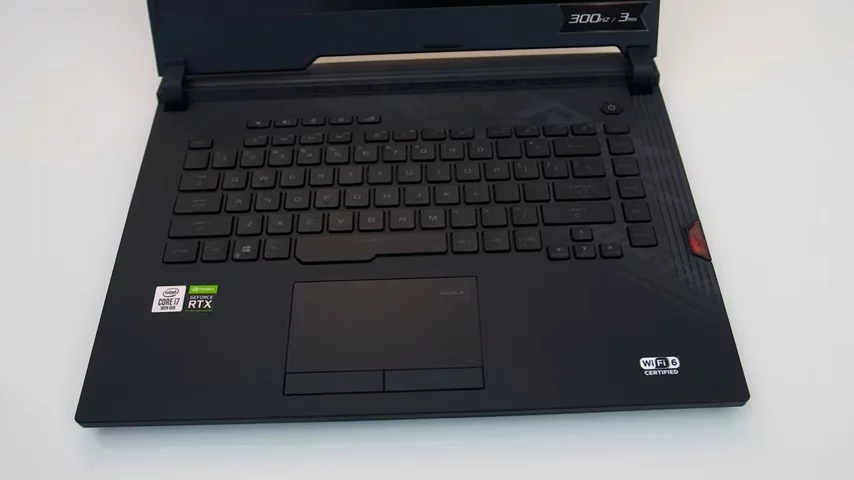 Weight distribution felt good, it sat fine on my lap, and this allows for it to be opened easily with one finger.
Weight distribution felt good, it sat fine on my lap, and this allows for it to be opened easily with one finger.
It weighs a bit over 2.3kg or 5lb, and after adding in the 230 watt power brick and cables we’re looking at 3.1kg or or under 7lb. 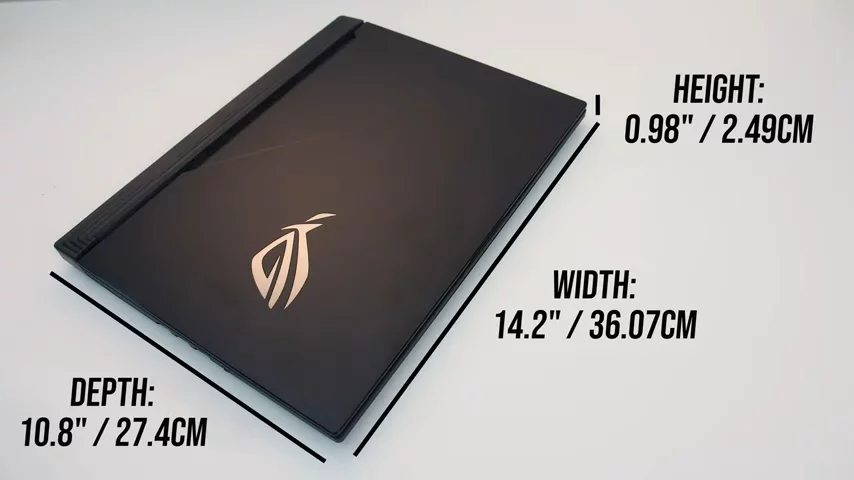 It’s not too thick given the specs inside, but was a little deeper compared to many other 15 inch machines as the back sticks out. My Scar 15 has a 15.6” 1080p 300Hz screen, no FreeSync or G-Sync, and no option of disabling optimus.
It’s not too thick given the specs inside, but was a little deeper compared to many other 15 inch machines as the back sticks out. My Scar 15 has a 15.6” 1080p 300Hz screen, no FreeSync or G-Sync, and no option of disabling optimus.
The ASUS Armoury Crate software gives us the option to enable or disable panel overdrive which affects screen response time. 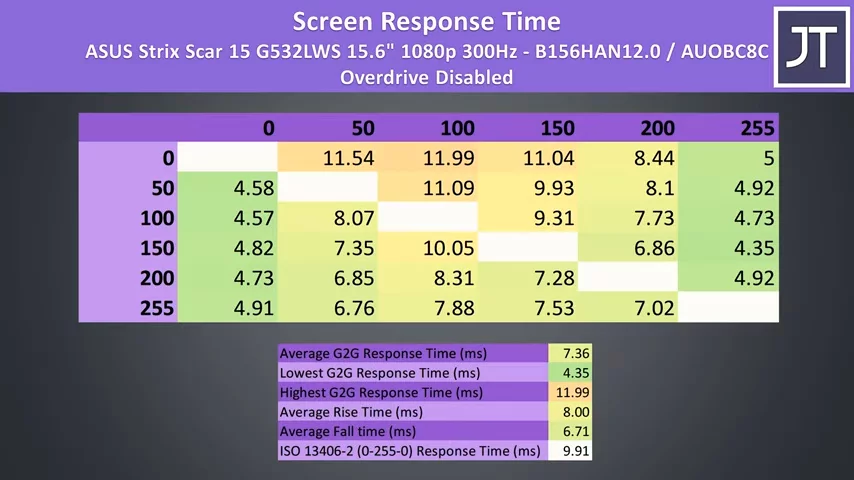 With overdrive off, we’re getting results that are typically closer to what we’d see from 144Hz screens, with an average grey-to-grey response time of about 7.4ms.
With overdrive off, we’re getting results that are typically closer to what we’d see from 144Hz screens, with an average grey-to-grey response time of about 7.4ms.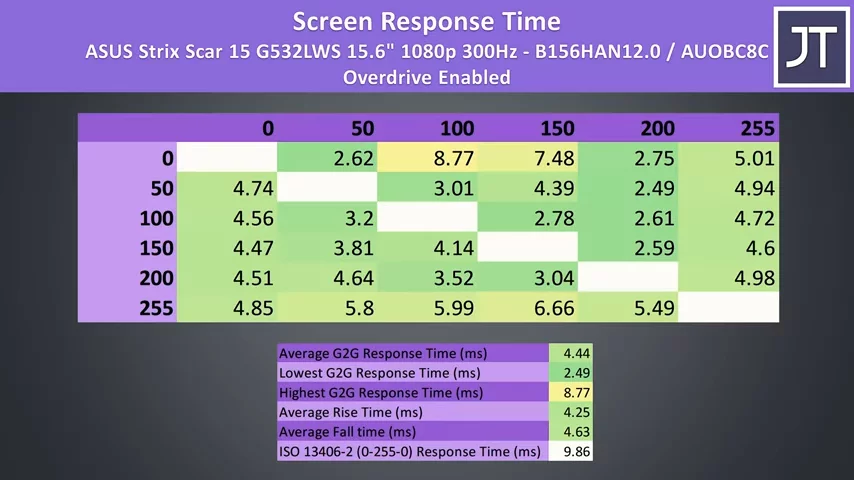 Once we enable overdrive, the average response time lowers to 4.44ms, so still a bit above the 3.33ms we need for all transitions to occur within the refresh window, though some transitions were under this.
Once we enable overdrive, the average response time lowers to 4.44ms, so still a bit above the 3.33ms we need for all transitions to occur within the refresh window, though some transitions were under this. 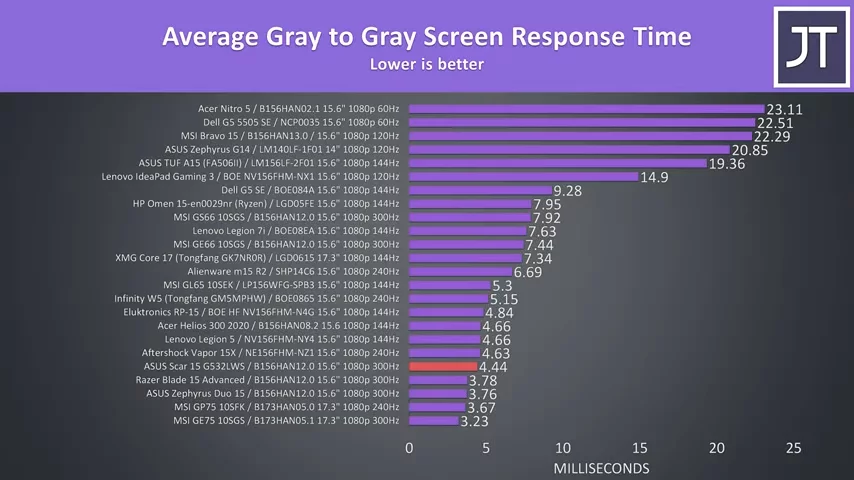 When compared to others, we can see it’s actually using the same panel as the Razer Blade 15 Advanced and ASUS Zephyrus Duo 15, so I’m guessing we’re just looking at some variance between the panels, leading me to believe results may vary a bit.
When compared to others, we can see it’s actually using the same panel as the Razer Blade 15 Advanced and ASUS Zephyrus Duo 15, so I’m guessing we’re just looking at some variance between the panels, leading me to believe results may vary a bit.
I’ve tested the screen with the Spyder 5, and got 96% of sRGB, 69% of NTSC, 75% of AdobeRGB and 75% of DCI-P3, decent results from a gaming laptop. My panel wasn’t quite able to get to 300 nits at 100% brightness, and the contrast ratio was pretty average at 820:1.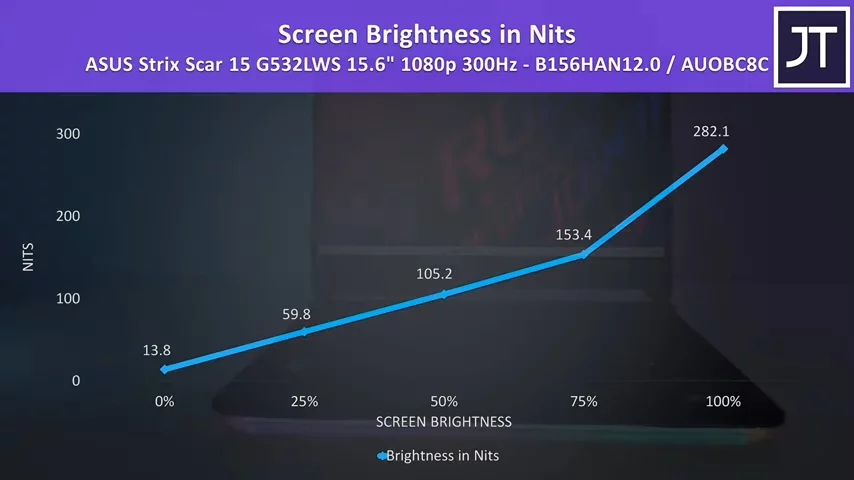 Backlight bleed was minor in my unit, but this will vary between laptops and panels.
Backlight bleed was minor in my unit, but this will vary between laptops and panels.  Like many other ASUS gaming laptops, there’s no camera here.
Like many other ASUS gaming laptops, there’s no camera here.
Although there’s no camera, it does still have a microphone. The chiclet keyboard has per key RGB backlighting, unfortunately the function keys up the top aren’t fully illuminated, and the secondary functions of other keys weren’t as bright as the main function.
Brightness can be adjusted between 3 levels with the function and up and down arrow keys, or left and right arrows can be used to cycle between lighting effects - but all of this can be done through software with more control too. I didn’t have any problems using the keyboard, though the arrow keys felt a little small, typing on it was fine.
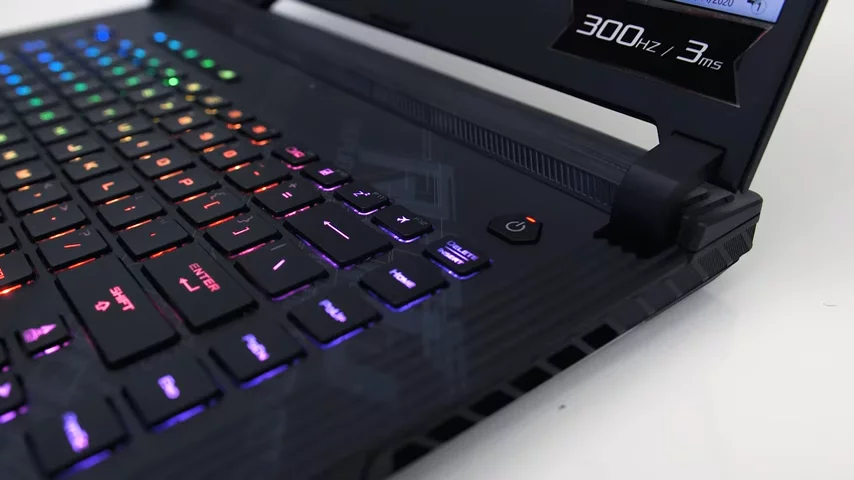 The power button is separate from the keyboard up the top right, there are also extra keys above the keyboard on the left to change volume, mute, enable turbo mode or open the Armoury Crate software, which is the control panel for the machine.
The power button is separate from the keyboard up the top right, there are also extra keys above the keyboard on the left to change volume, mute, enable turbo mode or open the Armoury Crate software, which is the control panel for the machine.
The precision touchpad is smooth and works fine. It doesn’t click down as it’s got separate left and right click buttons, and if you hold down the top right corner it enables numpad mode, as this is missing from the keyboard. Unfortunately you can’t use it as a touchpad until you disable numpad mode.
Fingerprints and dirt aren’t too obvious, more so on the touchpad, but either way the smooth surface was easy to clean with a microfiber cloth. 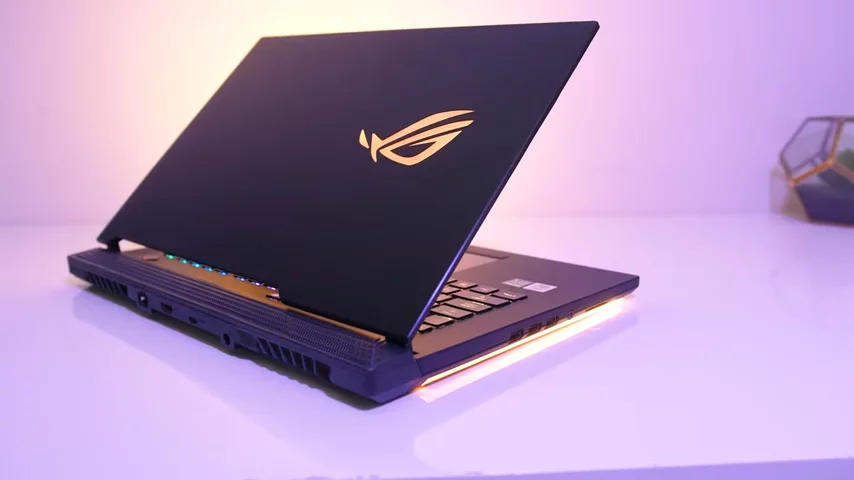 You’ve probably noticed by now that there’s an RGB light bar running along the front and both left and right sides of the machine, and this is in addition to the ROG logo on the lid which also has RGB lighting. I think you can customize these areas independently of the rest in the Aura Creator software as you can select them, but I couldn’t work it out easily, at the very least you can apply the same effect to the lid, keyboard and light bar together.
You’ve probably noticed by now that there’s an RGB light bar running along the front and both left and right sides of the machine, and this is in addition to the ROG logo on the lid which also has RGB lighting. I think you can customize these areas independently of the rest in the Aura Creator software as you can select them, but I couldn’t work it out easily, at the very least you can apply the same effect to the lid, keyboard and light bar together.
On the left we’ve got three USB 3.2 Gen1 Type-A ports and a 3.5mm audio combo jack. 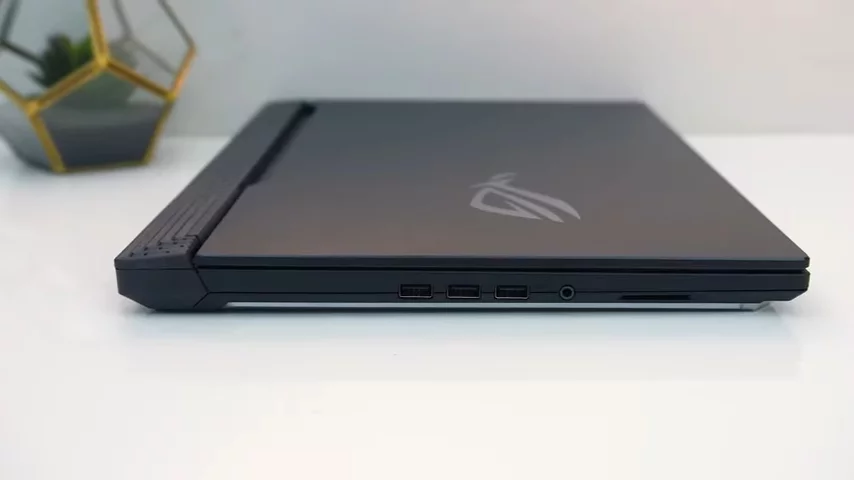 The right has the keystone, and there’s an air exhaust vent on this side, so nothing to get in the way of right handed mouse users.
The right has the keystone, and there’s an air exhaust vent on this side, so nothing to get in the way of right handed mouse users.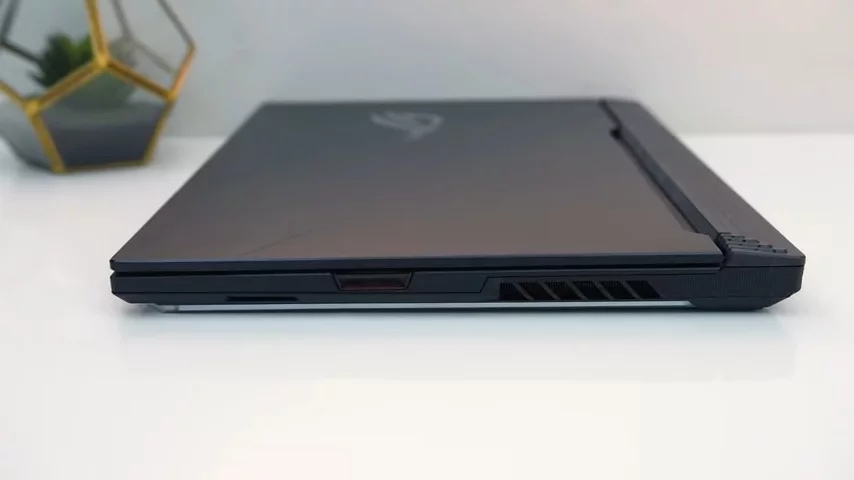 The keystone is this red key on the side which is held in by magnets,
The keystone is this red key on the side which is held in by magnets,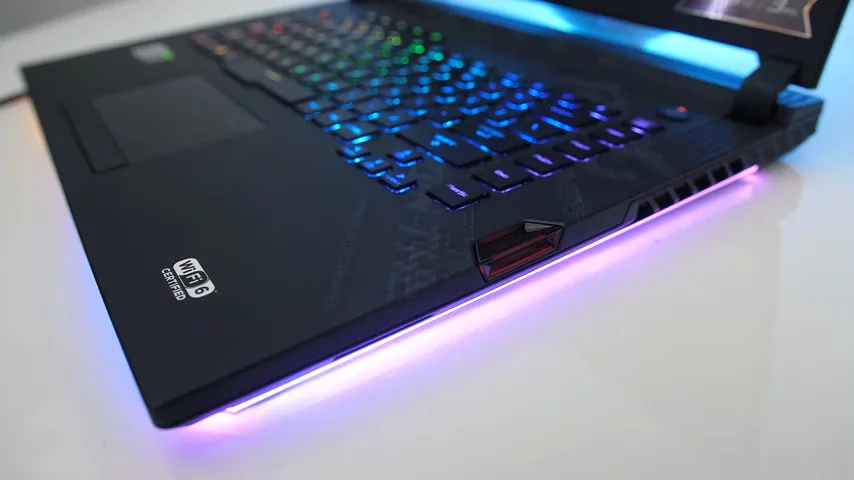 basically you can customize things on the system like lighting and performance profiles and bind them to the keystone, then when you connect it everything automatically changes to your settings, so I only really see it being useful if you’re sharing the laptop with other people. It can also be used to unlock a hidden encrypted drive, so you can store, uh, stuff.
basically you can customize things on the system like lighting and performance profiles and bind them to the keystone, then when you connect it everything automatically changes to your settings, so I only really see it being useful if you’re sharing the laptop with other people. It can also be used to unlock a hidden encrypted drive, so you can store, uh, stuff.
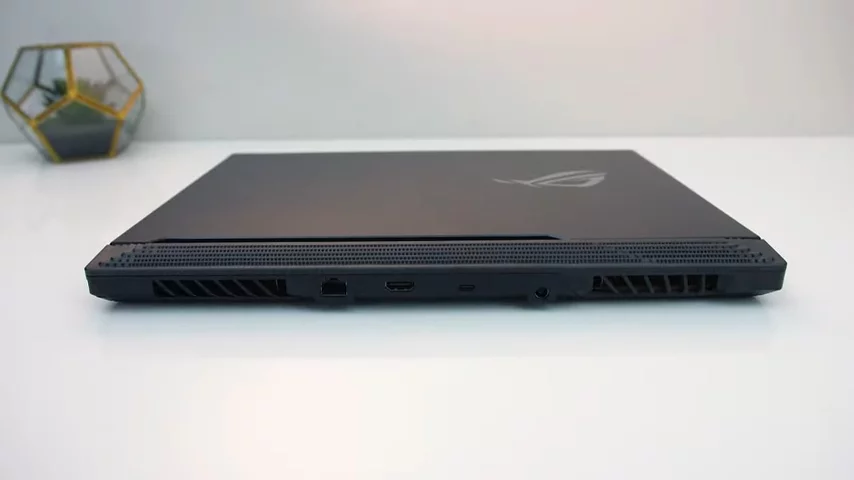 The back has two more air exhausts towards the corners, then from left to right a gigabit ethernet port facing the preferred way so you can easily pull the cable out without lifting the machine, HDMI 2.0b output, USB 3.2 Gen2 Type-C port, and the power input. Both the Type-C and HDMI ports connect directly to the Nvidia graphics, so VR should be possible. The Type-C port does not have Thunderbolt and cannot be used to charge the machine.
The back has two more air exhausts towards the corners, then from left to right a gigabit ethernet port facing the preferred way so you can easily pull the cable out without lifting the machine, HDMI 2.0b output, USB 3.2 Gen2 Type-C port, and the power input. Both the Type-C and HDMI ports connect directly to the Nvidia graphics, so VR should be possible. The Type-C port does not have Thunderbolt and cannot be used to charge the machine.
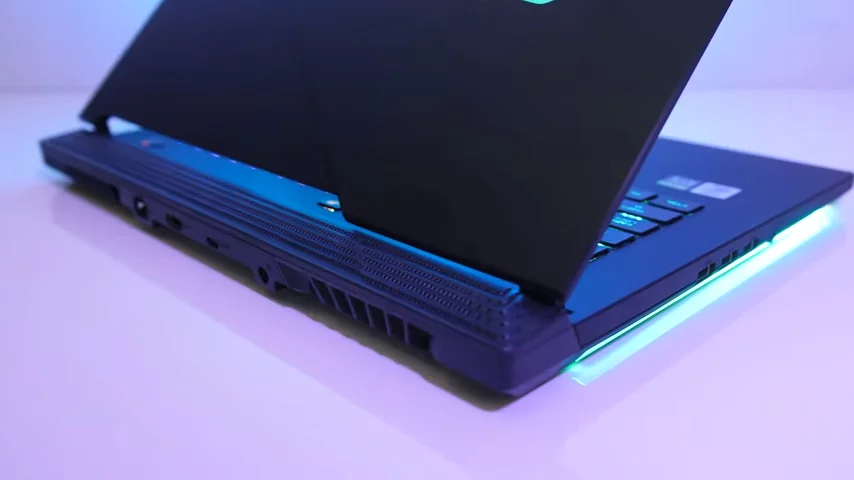 The back sticks out a bit and has some ventilation holes, and there’s a cut out under the screen which is meant to assist in allowing airflow into here.
The back sticks out a bit and has some ventilation holes, and there’s a cut out under the screen which is meant to assist in allowing airflow into here. 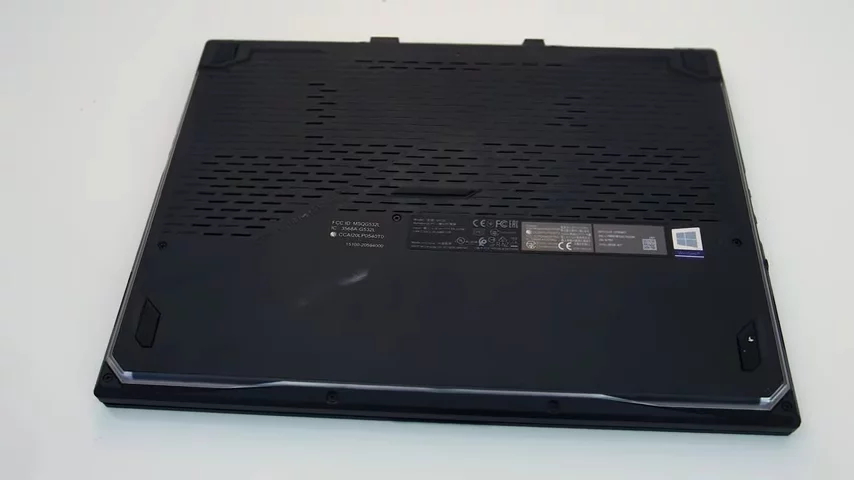 Underneath appears to not have air ventilation holes directly above the intake fans, they’re more towards the center, similar to other designs from ASUS like the TUF A15, we’ll check thermals shortly.
Underneath appears to not have air ventilation holes directly above the intake fans, they’re more towards the center, similar to other designs from ASUS like the TUF A15, we’ll check thermals shortly.
Getting inside requires removing 11 Phillips head screws, but the two down the front corners don’t come out of the panel and instead pop it up to help opening it. 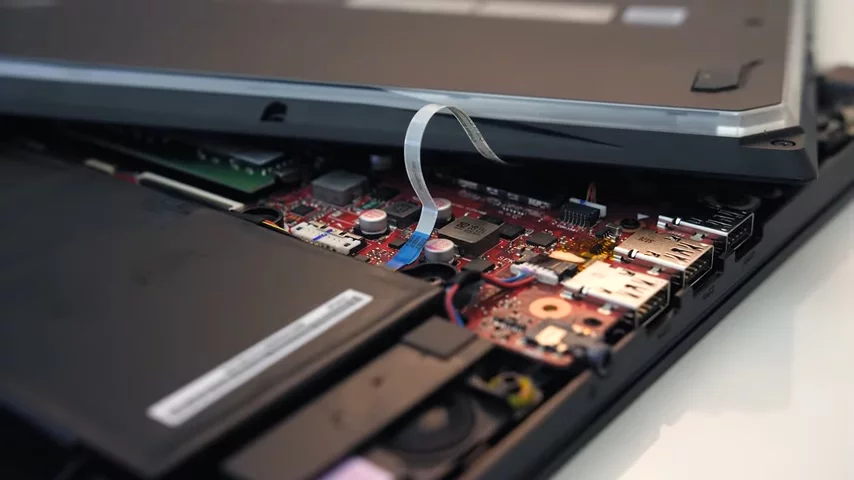 You’ve got to be careful when removing the bottom panel, as it’s attached to the motherboard by two ribbon cables for the RGB lighting.
You’ve got to be careful when removing the bottom panel, as it’s attached to the motherboard by two ribbon cables for the RGB lighting. 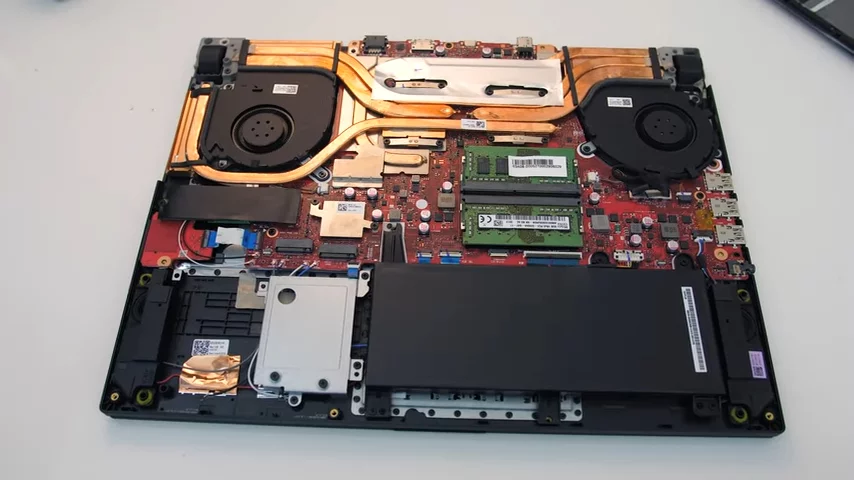 The battery is down the front. There appears to be space for a 2.5” drive bay next to it, though mounting hardware wasn’t provided, but the space can be used for two M.2 storage drives, meaning there are 3 in total.
The battery is down the front. There appears to be space for a 2.5” drive bay next to it, though mounting hardware wasn’t provided, but the space can be used for two M.2 storage drives, meaning there are 3 in total.
There are two memory slots near the middle, and the WiFi 6 card is hiding under the installed M.2 SSD. 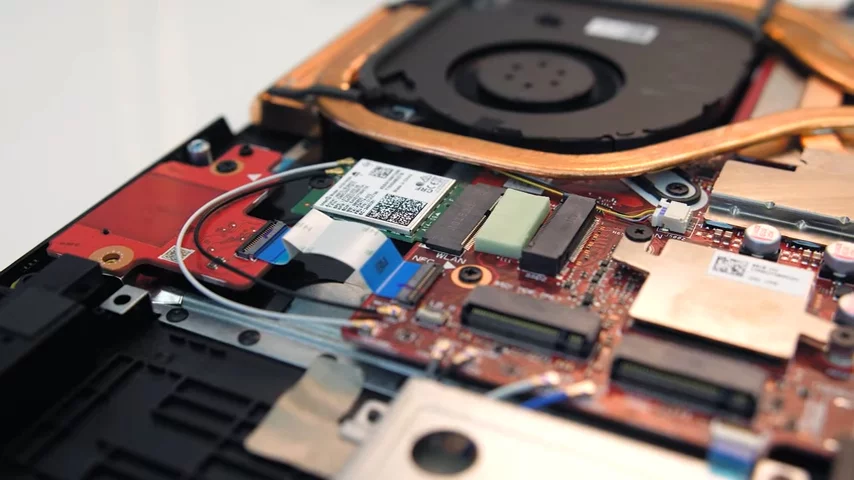 The two speakers are on the left and right sides towards the front, I thought they sounded alright, there’s some bass but they were a little tinny sounding, not as good as the Zephyrus M15 from ASUS that I’m testing at the same time, but the latencymon results were ok.
The two speakers are on the left and right sides towards the front, I thought they sounded alright, there’s some bass but they were a little tinny sounding, not as good as the Zephyrus M15 from ASUS that I’m testing at the same time, but the latencymon results were ok.
The Scar 15 is powered by a 4-Cell 66Wh battery. I’ve tested it with RGB lighting off, background apps disabled and screen at 50% brightness.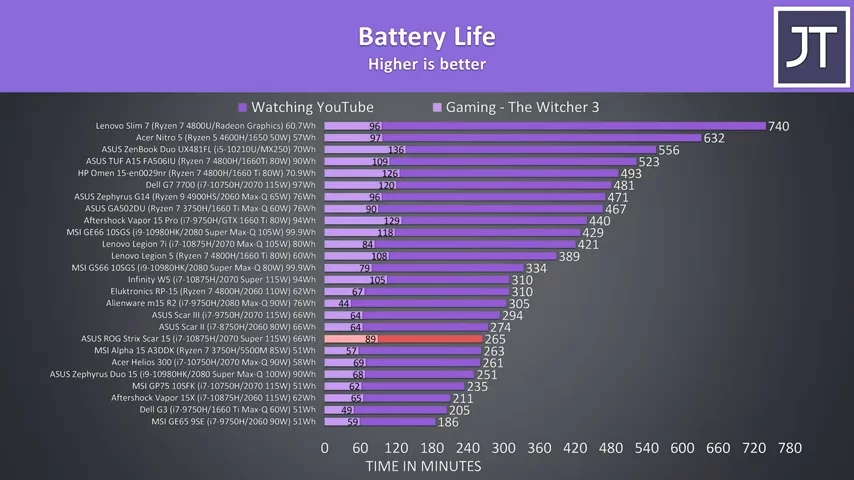 It only lasted for about 4 and a half hours, a lower result when compared to the Scar II and Scar III with the same size battery just above it, granted my Scar 15 does have higher tier specs which probably drain more power.
It only lasted for about 4 and a half hours, a lower result when compared to the Scar II and Scar III with the same size battery just above it, granted my Scar 15 does have higher tier specs which probably drain more power.
Like many other laptops from ASUS, when you unplug from wall power the screen will flash black while it automatically swaps from the 300Hz refresh rate to 60Hz to help save power. I wish more laptops had this feature, as it saves power and it’s unlikely you’ll be running any games well enough on battery power to take advantage of 300Hz anyway.
Let’s check out thermals next. ASUS are using liquid metal on the CPU here, as is the case with many of their Intel 10th gen lineup. By default there’s no undervolt, and undervolting is locked through software, however you can undervolt through the BIOS, but it’s capped at -0.08v. Still though, better than some others where it’s not possible at all.
The Armoury Crate software lets us pick between different performance modes, which from lowest to highest are silent, performance, turbo, then manual is kind of like turbo mode but you have more control, it lets you adjust fan speed. In the upcoming thermal tests, I found the fans in turbo mode were at the same speed as manual anyway, so I didn’t test them separately. 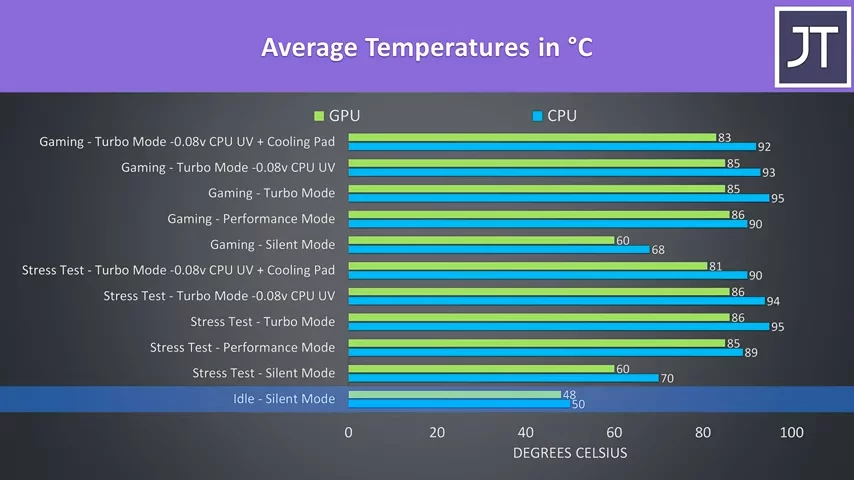 The idle temperatures were ok with a 21 degree Celsius ambient room, stress tests were done with the Aida64 CPU stress test with stress CPU only checked and the Heaven GPU benchmark run at the same time, while gaming was tested playing Watch Dogs 2. The CPU was thermal throttling in turbo mode at 95 degrees Celsius, though the undervolt starts to lower this, and then the cooling pad helps a little extra.
The idle temperatures were ok with a 21 degree Celsius ambient room, stress tests were done with the Aida64 CPU stress test with stress CPU only checked and the Heaven GPU benchmark run at the same time, while gaming was tested playing Watch Dogs 2. The CPU was thermal throttling in turbo mode at 95 degrees Celsius, though the undervolt starts to lower this, and then the cooling pad helps a little extra.
The cooling pad isn’t helping too much however, less so when compared to other laptops tested which I suspect is due to the bottom panel not having holes directly over the intake fans, so it’s not as useful. The GPU was also thermal throttling at 86 degrees Celsius, and this was happening or was otherwise not far off it. The temps look good in silent mode, but when we look at the clock speeds we can see the GPU is only running at 300MHz.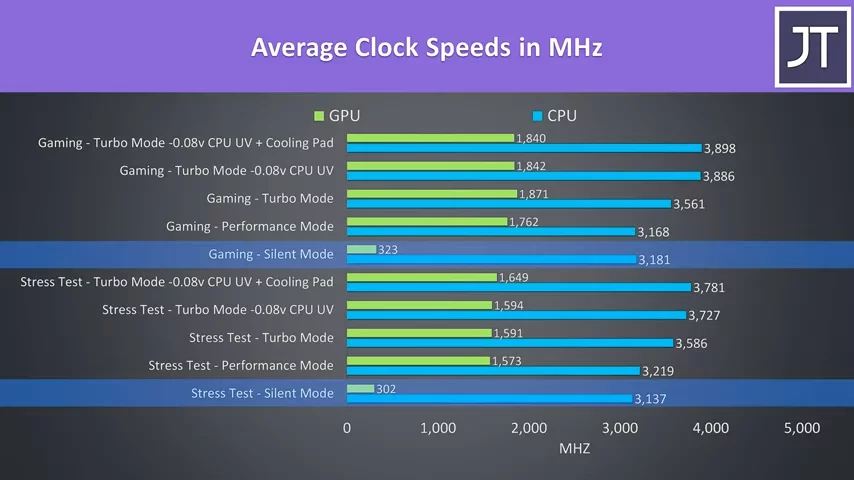 This is next to useless for most modern games, and during my test the game was unplayable, so I wouldn’t count on silent mode for tasks that require GPU power. The GPU didn’t change much in the other modes, while the CPU gets a bit better with turbo mode, then more with the undervolt, then we can see how small the difference with the cooling pad was.
This is next to useless for most modern games, and during my test the game was unplayable, so I wouldn’t count on silent mode for tasks that require GPU power. The GPU didn’t change much in the other modes, while the CPU gets a bit better with turbo mode, then more with the undervolt, then we can see how small the difference with the cooling pad was.
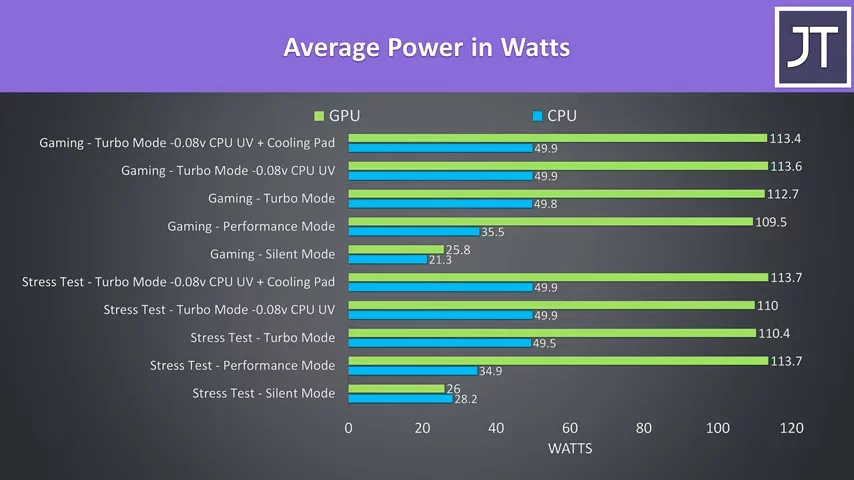 The 2070 Super was able to run up to its 115 watt limit in performance and turbo modes, but it seems to be capped to around 25 watts in silent mode which explains the low performance. Performance mode appears to cap the processor at 35 watts, while turbo mode raises this up to 50 watts. I didn’t bother attempting to increase PL1 because as we saw just before, thermal throttling was already being hit or it was close.
The 2070 Super was able to run up to its 115 watt limit in performance and turbo modes, but it seems to be capped to around 25 watts in silent mode which explains the low performance. Performance mode appears to cap the processor at 35 watts, while turbo mode raises this up to 50 watts. I didn’t bother attempting to increase PL1 because as we saw just before, thermal throttling was already being hit or it was close.
Here’s how game frame rates differed with these different modes in use, 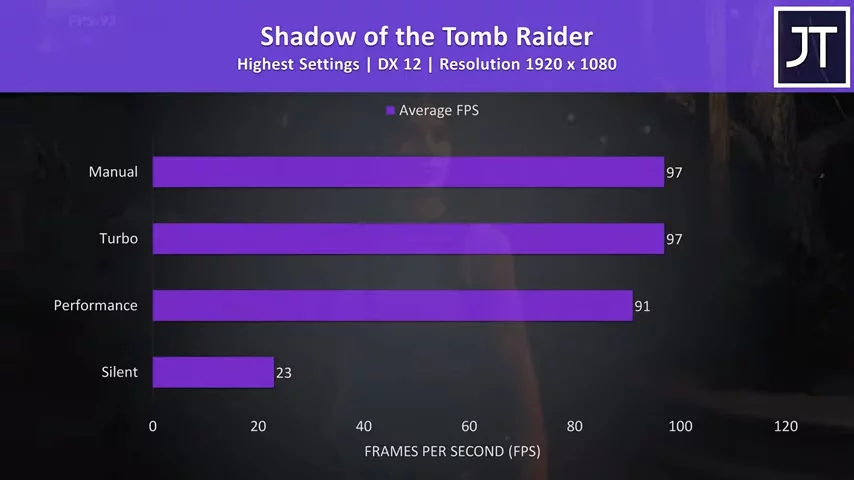 turbo and manual mode were the same as expected, then lower results with the lower modes.
turbo and manual mode were the same as expected, then lower results with the lower modes.
Here’s how CPU only performance looks in Cinebench with the GPU now idle,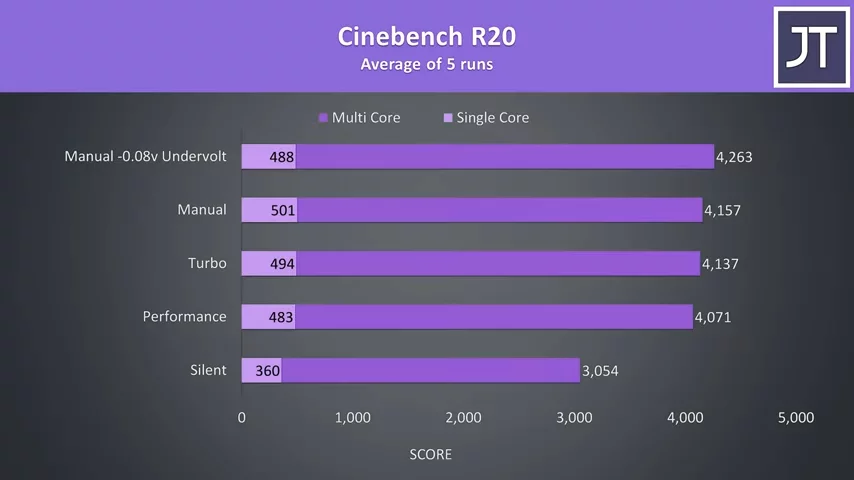 so not too much of a difference between performance mode or turbo mode in a CPU only workload compared to what we just saw with the GPU also active, where there was a bigger difference.
so not too much of a difference between performance mode or turbo mode in a CPU only workload compared to what we just saw with the GPU also active, where there was a bigger difference. 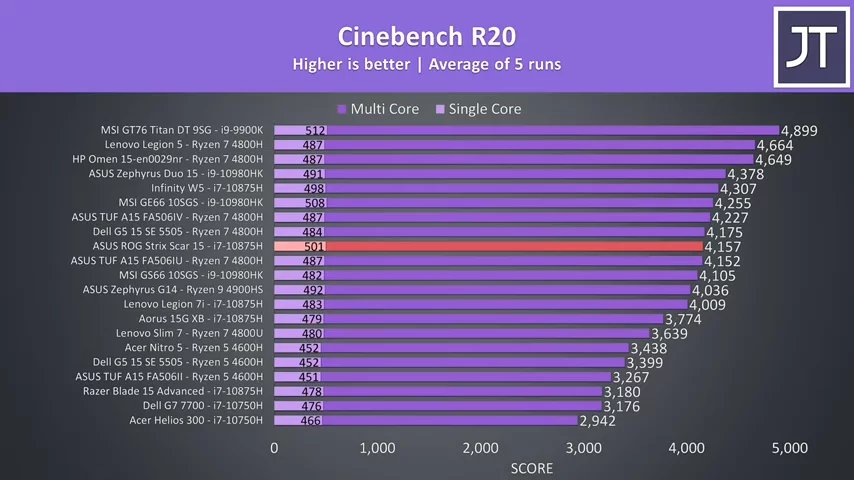 When we look at how it compares against others, the single core result is still quite decent when compared to the Ryzen competition, but the multicore score is behind other cheaper Ryzen alternatives.
When we look at how it compares against others, the single core result is still quite decent when compared to the Ryzen competition, but the multicore score is behind other cheaper Ryzen alternatives.
When idling the keyboard was around the low 30 degree Celsius point which is pretty normal. 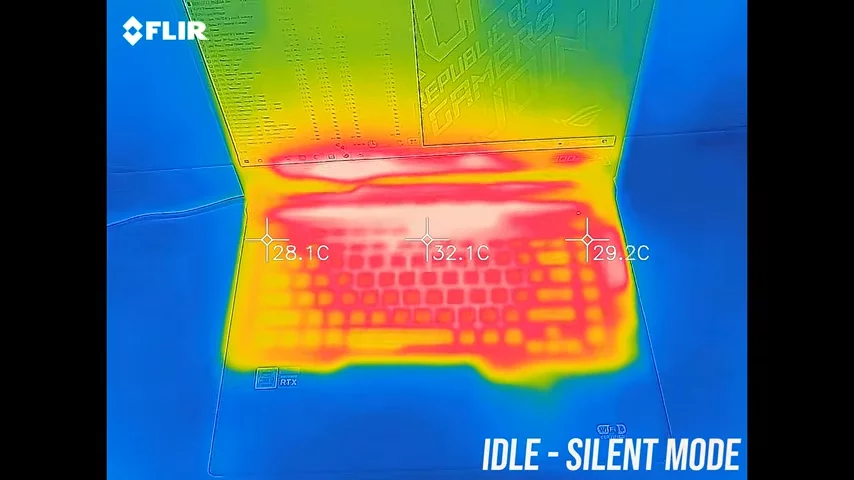 With the stress tests running in silent mode it’s only in the mid 30s in the center now, still low, but as we saw the power limits are capped pretty heavily here.
With the stress tests running in silent mode it’s only in the mid 30s in the center now, still low, but as we saw the power limits are capped pretty heavily here. 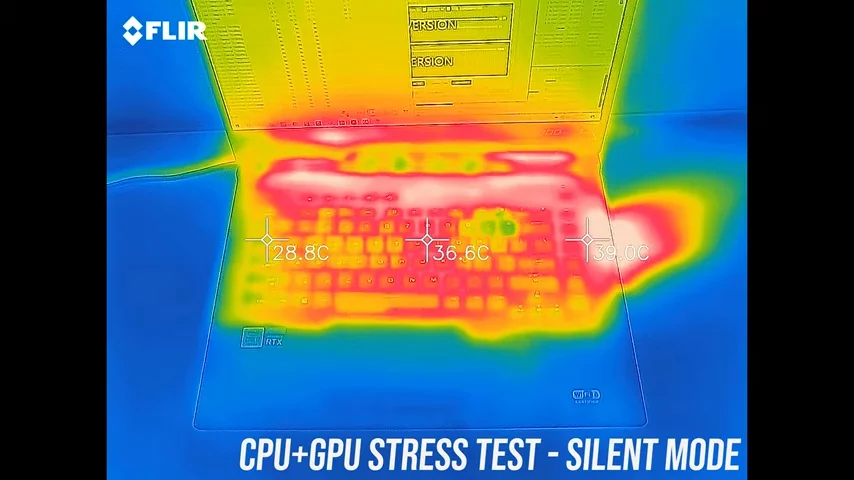 Performance mode wasn’t too different, a bit warmer up the back where you don’t really need to touch.
Performance mode wasn’t too different, a bit warmer up the back where you don’t really need to touch.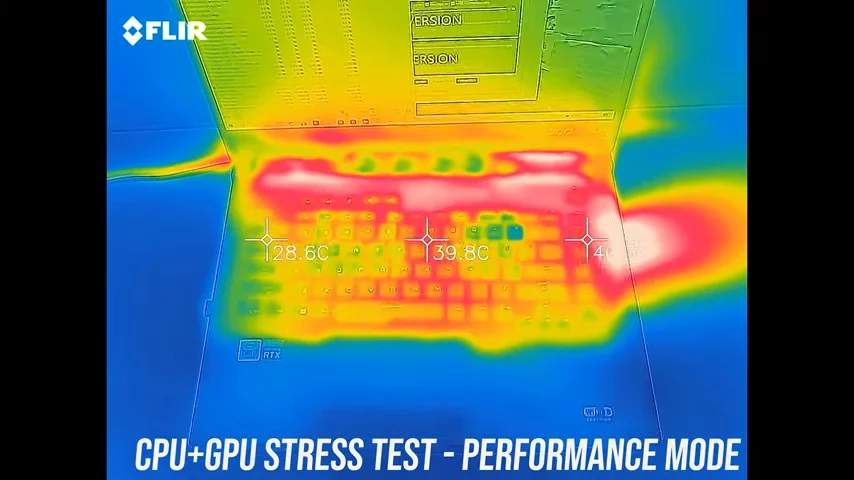 In turbo mode it’s still only low 40s in the middle, so just warm feeling and not an issue.
In turbo mode it’s still only low 40s in the middle, so just warm feeling and not an issue.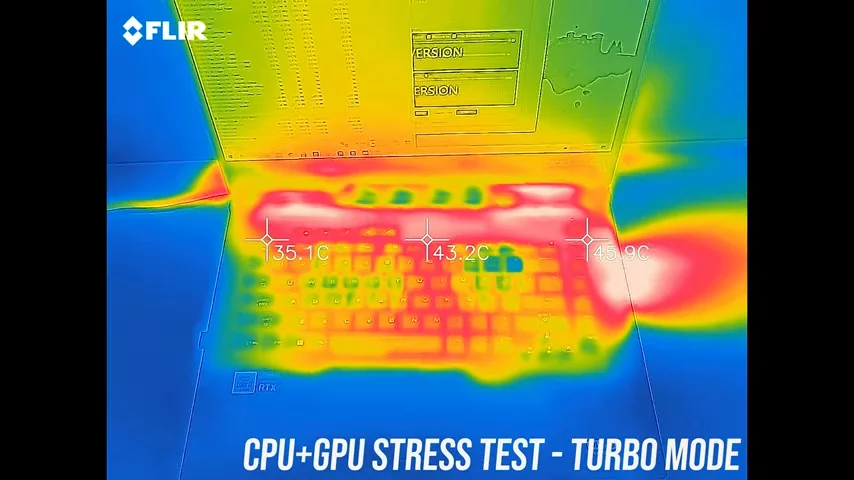
It sounded silent to me at idle. It was on the quieter side even under load in silent mode, but again, low power limits means low performance here, that’s the trade off. Performance mode was similar to many other laptops that I’ve tested, but then turbo mode was a little louder, and as mentioned in this test was the same as using manual mode to manually set the fans to full speed. N
ow let’s check out how well the Scar 15 performs in games and see how it compares with other laptops.
I’ve tested Battlefield 5 in campaign mode at ultra settings, and the Scar 15 is highlighted in red. 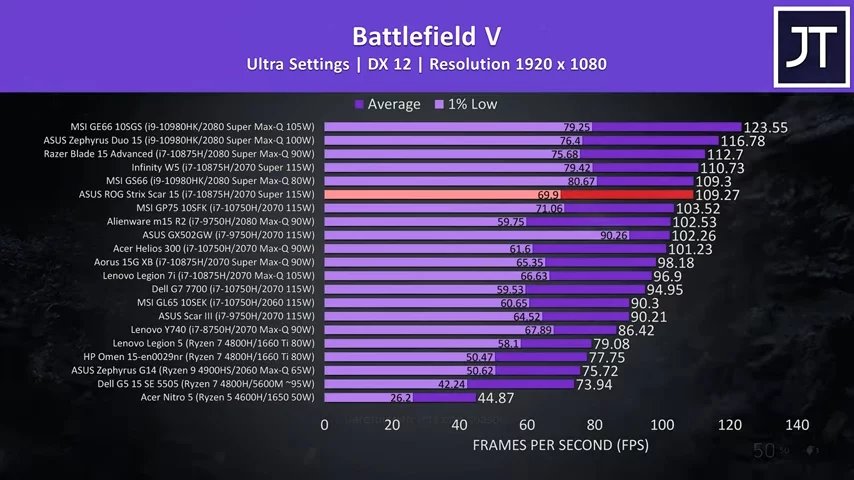 I don’t have too much other 115w 2070 Super data yet. Compared to other machines this is a nice result, though the Infinity W5, aka Eluktronics Mech-15 G3 with the same CPU and GPU was one FPS ahead, but it was about 10 FPS higher in 1% low, probably a result of being able to disable optimus which the Scar unfortunately does not offer.
I don’t have too much other 115w 2070 Super data yet. Compared to other machines this is a nice result, though the Infinity W5, aka Eluktronics Mech-15 G3 with the same CPU and GPU was one FPS ahead, but it was about 10 FPS higher in 1% low, probably a result of being able to disable optimus which the Scar unfortunately does not offer.
These are the results from Far Cry 5 with ultra settings in the built in benchmark. 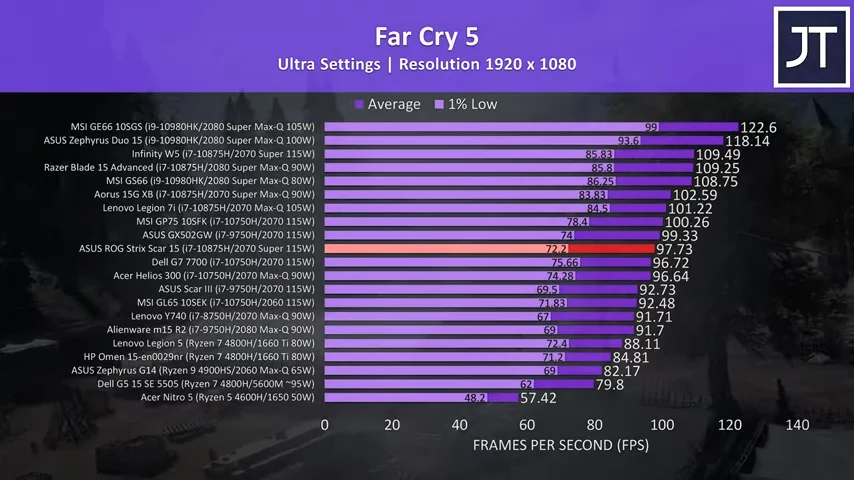 The position of the Scar 15 drops back a bit now compared to the same selection of laptops. This test tends to be more dependent on the processor, and it’s the lowest result I’ve got with the 10875H here.
The position of the Scar 15 drops back a bit now compared to the same selection of laptops. This test tends to be more dependent on the processor, and it’s the lowest result I’ve got with the 10875H here.
Shadow of the Tomb Raider was also tested with the games benchmark tool with the highest setting preset.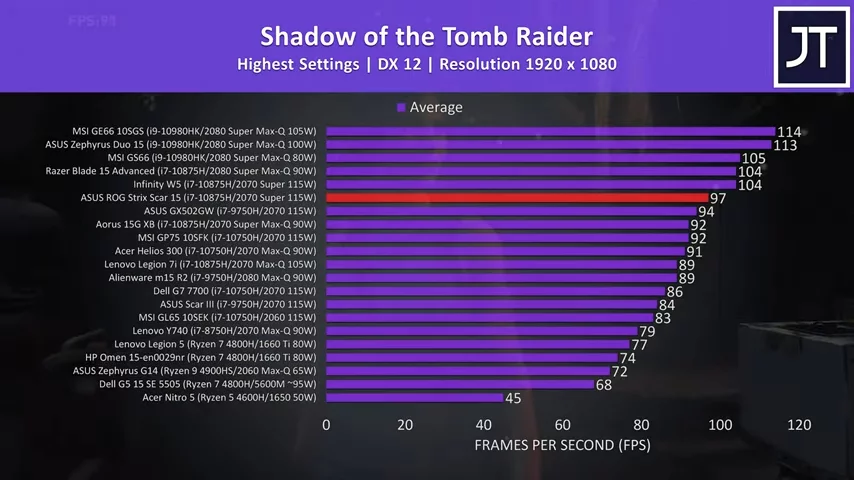 The Scar 15 was back in the same position as Battlefield V now as this is more of a GPU heavy test, though it’s still 7 FPS below the machine above it with the same CPU and GPU, again due to the tweaks that one offers, but regardless still a pretty good result compared to most others. I’ve also tested the Scar 15 in 20 games at all setting levels, check the card in the top right or link in the description if you want more benchmarks.
The Scar 15 was back in the same position as Battlefield V now as this is more of a GPU heavy test, though it’s still 7 FPS below the machine above it with the same CPU and GPU, again due to the tweaks that one offers, but regardless still a pretty good result compared to most others. I’ve also tested the Scar 15 in 20 games at all setting levels, check the card in the top right or link in the description if you want more benchmarks.
Now for the benchmarking tools.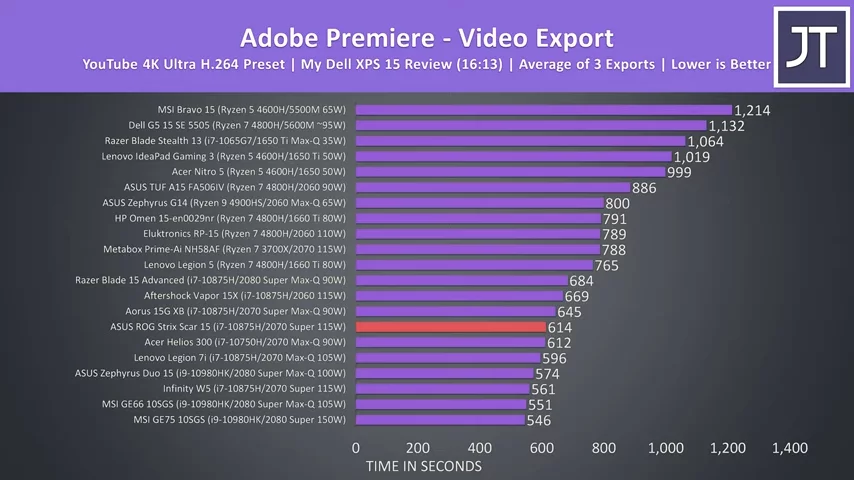 I’ve used Adobe Premiere to export one of my laptop review videos at 4K. Lower times are better here, and the Scar 15 was beaten by the W5 with the same specs.
I’ve used Adobe Premiere to export one of my laptop review videos at 4K. Lower times are better here, and the Scar 15 was beaten by the W5 with the same specs.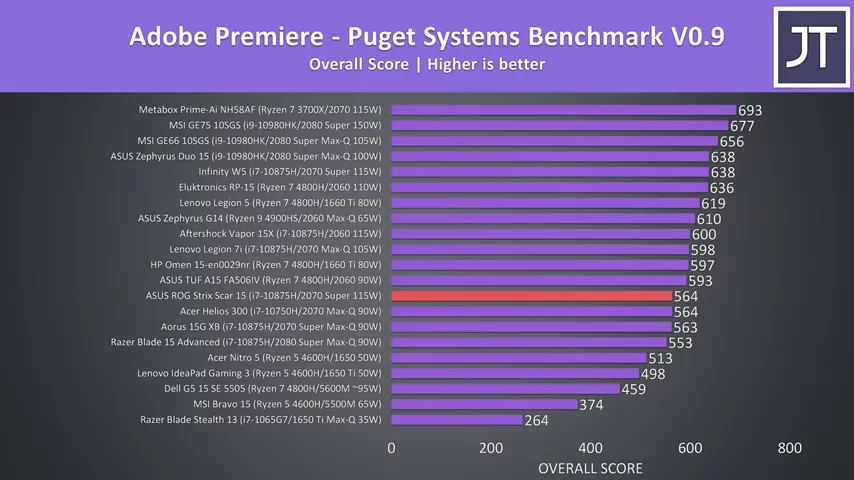 I’ve also tested Premiere but with the Puget systems benchmark. In these tests a higher score is better, and the score wasn’t that impressive given the cheaper Legion 5 with Ryzen and 1660 Ti was beating it.
I’ve also tested Premiere but with the Puget systems benchmark. In these tests a higher score is better, and the score wasn’t that impressive given the cheaper Legion 5 with Ryzen and 1660 Ti was beating it. 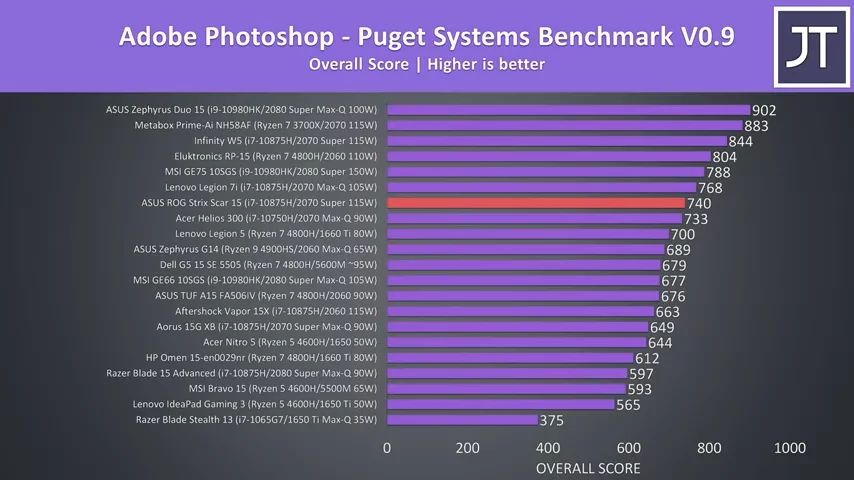 The Scar 15 moves up a few positions out of the same selection of machines in Adobe Photoshop, though it’s still behind the W5 with the same specs again.
The Scar 15 moves up a few positions out of the same selection of machines in Adobe Photoshop, though it’s still behind the W5 with the same specs again.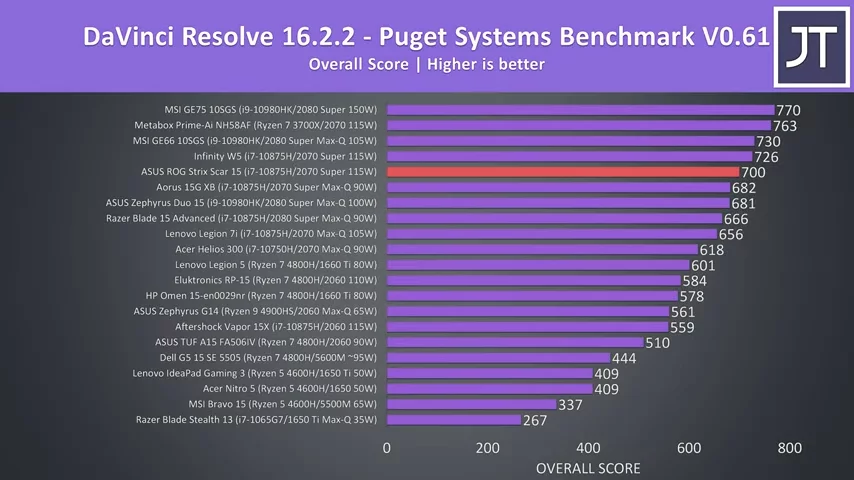 DaVinci Resolve is more GPU heavy, and the 115 watt RTX 2070 Super was doing well here, still slightly under the W5 but the scores are much closer together now.
DaVinci Resolve is more GPU heavy, and the 115 watt RTX 2070 Super was doing well here, still slightly under the W5 but the scores are much closer together now.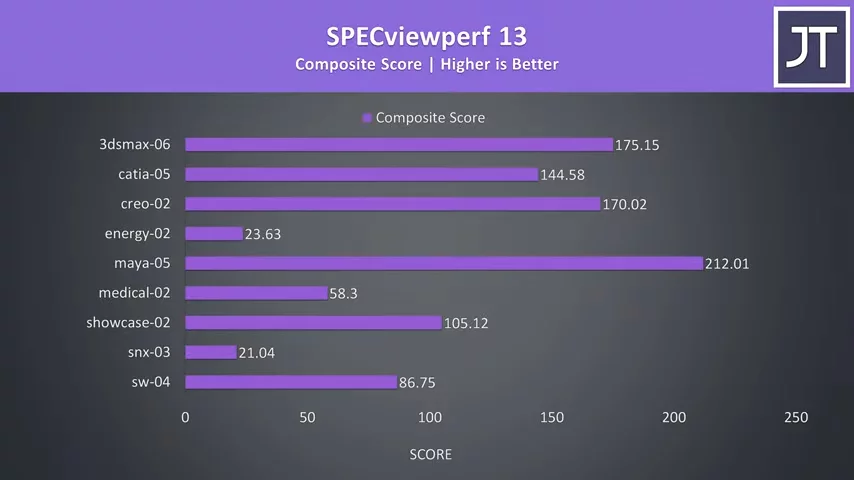 I’ve also tested SPECviewperf which tests out various professional 3D workloads.
I’ve also tested SPECviewperf which tests out various professional 3D workloads.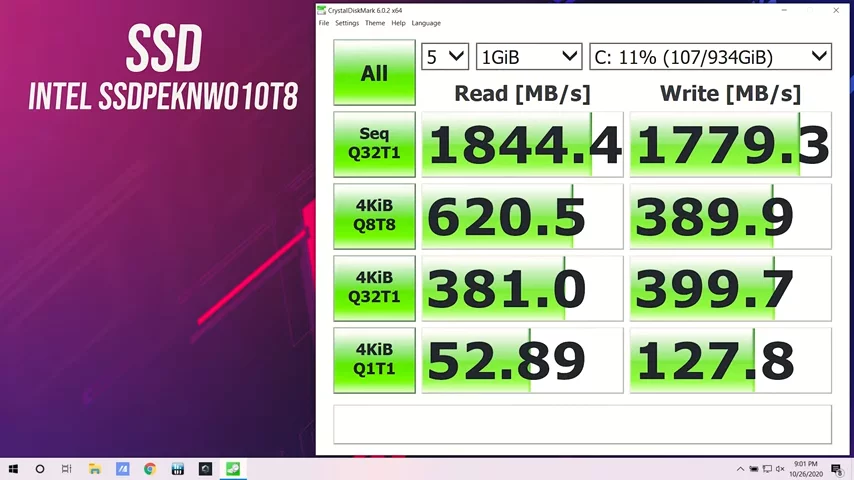 I’ve used Crystal disk mark to test the 1TB NVMe M.2 SSD, and the speeds were decent but not top tier like some other options at this price point.
I’ve used Crystal disk mark to test the 1TB NVMe M.2 SSD, and the speeds were decent but not top tier like some other options at this price point.
Speaking of prices, in the US it’s available for around $2100 USD with the same overall specs, though this one has a 240Hz screen instead. For $800 less though you can get it with 6 core i7, half the storage, 144Hz screen and 2060 though, so there are options.
Now with all of that in mind let’s summarise both the good and the bad to help you decide if the Scar 15 is worth buying.
The build quality was decent despite the interior being plastic, this is probably a result of it being nearly an inch thick. I expected thermals to do better as a result of liquid metal, and I guess with this area sticking out the back with extra ventilation, but this wasn’t the case. This isn’t to say that liquid metal isn’t helping, but that even with it we’re still seeing thermal throttling on both the CPU and GPU while gaming even in a cool room. Fortunately ASUS does at least give us the option of applying an undervolt through the BIOS which does help, but even with this and a cooling pad we’re not able to pass 3.9GHz over all 8 cores on the 10875H in combined CPU plus GPU load. That’s not too terrible, there are just other laptops that I’ve tested that can do this that don’t have liquid metal.
A cooling pad hardly helps due to a lack of holes for airflow directly above the intake fans, which could in part also be a reason for the throttling. It’s the same sort of design we saw in the ASUS TUF A15, and people have shown how that ran cooler with the bottom panel off despite ASUS saying the design was to allow air to flow over other components.
My main concern is that I test in a somewhat cool room, while temperatures wouldn’t increase even in a hotter environment as we’re hitting the temperature limits, it would mean worse performance as the components would throttle back more, so that may be an issue if you live in a hotter environment.
Now regardless of possible CPU and GPU thermal throttle limits being hit, the performance in gaming was quite good, as you’d expect from the 2070 Super graphics, but I still think it’s unfortunate that we’re not given the option of disabling optimus, as this would give us a performance boost and make the 300Hz screen more useful in esports titles.
The screen otherwise had good colour gamut and response time with overdrive enabled, though brightness wasn’t quite where I’d want it to be, but that can vary a bit between panels. Battery life wasn’t amazing, but that’s generally going to be the case with higher end specs like this, so perhaps it makes more sense to instead take advantage of that space to include three M.2 storage slots.
There’s plenty of RGB lighting here which will of course be subjective, but you can control it or disable it if it’s not your thing. Unfortunately there’s no camera here, a choice I believe ASUS made pre human malware happening which I’m sure they’re probably regretting with so many people now requiring a built in camera.
All things considered, the Scar 15 isn’t a laptop for me personally, but if you like the RGB lighting and want a fast screen for gaming compared to many other alternatives then it could be worth considering. Just don’t assume that liquid metal is going to prevent throttling and keep things running cool.
Let me know what you thought about the ASUS Scar 15 gaming laptop down in the comments.
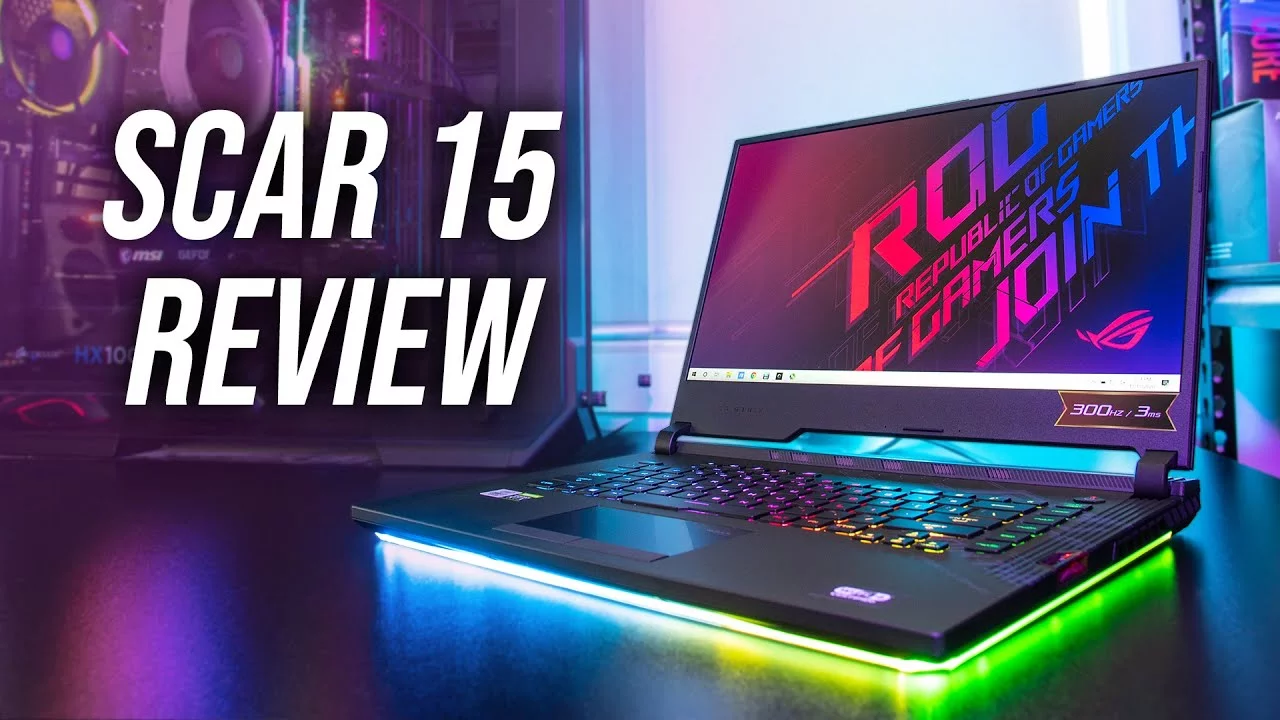

No comments yet